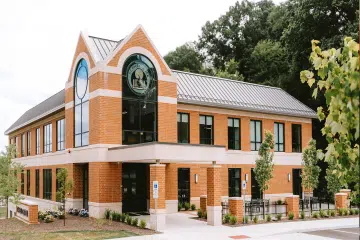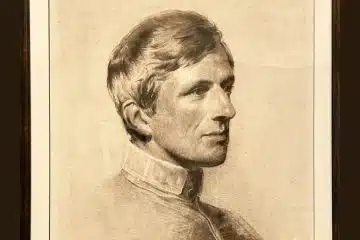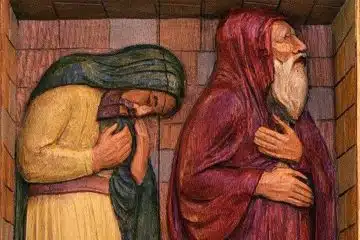Radiate Christ: A Pastoral Letter to the Faithful of the Archdiocese
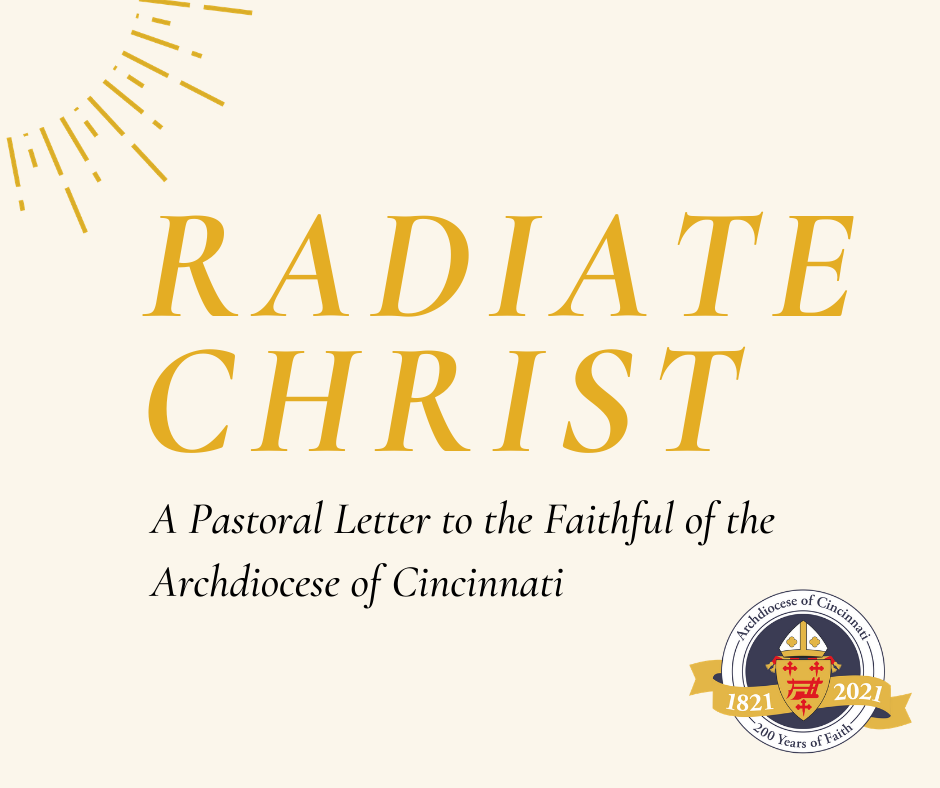 To download Archbishop Schnurr’s Pastoral Letter, click Pastoral Letter PDF
To download Archbishop Schnurr’s Pastoral Letter, click Pastoral Letter PDF
My dear brothers and sisters in Christ,
Radiate Christ. These two words summarize God the Father’s hope for humanity on this earth. The words contain both a reality and a mission: the reality of the person of Jesus Christ as the Savior of all people and the mission of each Christian to participate in the Son’s redemption of the world.
The occasion of the bicentennial celebration of the Archdiocese of Cincinnati affords us an opportunity to reflect on this reality and this mission as they exist in our local Church. As we begin our celebration of this great milestone, we forge ahead into a grace-filled period of reflection and examination to bring about a greater vitality and stronger, even more life-giving Christianity. To the degree that we each strive to be converted to the Lord Jesus, we will be strengthened as an archdiocese made up of disciples who encounter, know and follow the Lord who has led us to this point.
Searching for Meaning in a World Wounded by Sin
Our modern age presents us with easy access to goods and information. We know that it is nearly impossible to spend a day without searching the internet. We seek answers to curiosities; we figure out how to do things; we have access to more information about the goings-on in the world than ever before. Seemingly, anything we want is available at the click of a button. Searching and consuming become habitual, and yet we never find enough to be truly satisfied. Despite so much being available, it is all too apparent that we live in a world that is hurting. Something is always lacking. This world in which we live, which is at times beautiful and capable of stirring in us wonder of the divine, is also clearly not the world as God intended it to be. The symptoms of sin ripple across the surface of every time and place, and its effects run deeper, causing unrest in the souls of individuals and anxiety and even turmoil on a larger scale. Every human being is searching for meaning and fulfillment in this world wounded by sin. That fulfillment, that perfect satisfaction and happiness for which we were created, is only found in relationship with God. The Catechism of the Catholic Church reminds us, “The desire for God is written in the human heart, because man is created by God and for God; and God never ceases to draw man to himself. Only in God will he find the truth and happiness he never stops searching for” (CCC 27).
God the Father has offered fulfillment to us through His Son, Jesus Christ. It is He who longs to satisfy our tireless searching. He alone has come that we might have life and life in abundance (John 10:10). This abundance of life is not the product of possessing things nor is it a lack of hardship or loss during the time we are given on this earth. No, the abundance of life that Jesus promises is not just a good life according to the measures of the world. True life, the fullness of life, is that which radiates the peace and joy which come from a relationship with Jesus Christ who alone can restore our worldly humanity to the divine perfection which God planned for it in the beginning.
Only in heaven, united completely to God, do we hope to experience the perfection of that fullness of life. Even so, in this earthly life we can still enjoy a foretaste of that ultimate goodness for which we long. When we do that, when we accept God’s invitation to abide in Him and so possess His joy (John 15: 9-11), we become His witnesses to the world.
This is my hope: that each of us, within our unique and personal circumstances and situations, becomes a more joyful witness of the goodness of a life lived in relationship with Jesus Christ. As Pope Saint Paul VI said, “Modern man listens more willingly to witnesses than to teachers, and if he does listen to teachers, it is because they are witnesses” (Evangelii Nuntiandi, 41). This remains very, very true today. The world in which we live is not the world as God intended it to be. It is hurting; it needs hope. Let us more fully open ourselves to Jesus. Let us welcome Him into our lives so that He can work through our lives. Let us be witnesses. Let us radiate Christ.
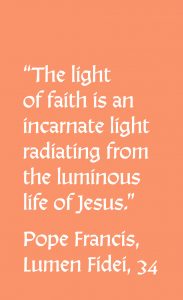 1821 Forward: The growth of a believing community
1821 Forward: The growth of a believing community
When Pope Pius VII established the Diocese of Cincinnati in June of 1821, and appointed Father Edward Dominic Fenwick, OP, as its first bishop, the diocese not only spanned all the lands of Ohio and Michigan, but it also extended through much of the former Northwest Territory and beyond. As the faith continued to grow over the next 50 years, other dioceses were apportioned from the Diocese of Cincinnati, which took on its current boundaries in western and southwestern Ohio in 1868. Such development of the local Church would not have been possible without the spiritual growth of the believing community. The believing community developed and responded to the needs of the day through committed individuals who allowed Christ to transform their lives. These converted Christians formed the families, groups and larger communities that gave and continue to give dynamic life to the Church.
Where do we experience God and the Church?
The Church exists in the interplay of these various levels of experience. As individuals we strive to know and be transformed by Jesus Christ so we can follow Him back to union with the Father, but we cannot do this alone. We cannot return to the God who created us out of love without the help and support of other Christians. This is why God gives us the Church. Our individual faith is strengthened when it is shared, and we find the courage to make the sacrifices of fidelity when others guide and inspire us.
Our immediate experience of the Church is through the people closest to us – even if we do not always think of it this way. We first experience the Church through our families: our parents, grandparents, brothers, sisters and extended family. Secondarily, we experience the Church through our friends, neighbors, co-workers, teams and classmates. These are the people God has placed in our lives, and we in theirs, to build each other up. These are the people upon whom our joyful and faithful witness can have the most effect. Jesus told us, “Where two or three have met together in my name, I am there among them” (Matthew 18:20). How true that is! When the individual members of these smaller groups radiate Christ to each other, the group takes on its own divine radiance. These small groups can then transform the larger structures they are part of: our parishes, neighborhoods, schools and workplaces. When these larger communities radiate Christ, then the Church makes Christ present to the world.
Laying the foundations
As we look at how the Archdiocese of Cincinnati has developed over the past 200 years, we can see that the Church responded to various needs through its institutions. Very early on in our history, religious women and men took up residence in the area to begin the work of laying the foundations of a strong life of faith. As the faith of the people grew broader and deeper, parishes were established; schools, universities and hospitals were built. Faithful women and men created and participated in diocesan and regional programs of service to those in need. All of these things have borne much fruit for our sisters and brothers in the Church and for our neighbors of different faiths, as well. The Archdiocese of Cincinnati has been well-served through its parishes, religious communities, schools, fraternal organizations and charitable institutions.
Today we are blessed with a well-established system of resources to serve the needs of our people and communities. We no longer have the need to strategically plan for extraordinary growth. Upkeep, renovation and renewal will always be necessary, but the main impetus of physically building Church infrastructure is behind us. We are now in a time of rapid change, requiring us to be adaptable to modern needs while maintaining our commitment to Jesus Christ. This opens up a great possibility for us. I would even say that this charges us with a great responsibility, to shift our focus towards our families, our smaller faith groups and, even more importantly, to our individual relationships with Jesus Christ.
Pope Francis has said, “The Lord wants to make use of us as living, free and creative beings who let His word enter our own hearts before then passing it on to others (Evangelii Gaudium, 151). To the degree that each of us individually lives in greater contact and dependence on Jesus Christ, all of our families, groups and larger communities will more perfectly reflect His radiance. The interaction of all of these parts – individuals, families, groups and larger communities – is how the Church functions to make Christ present to the world. As a member of the Body of Christ, each of us shares in the mission of Jesus and His Church: to bring salvation to each and every person.
Our celebration of the bicentennial of the Archdiocese of Cincinnati is a chance for each of us to reflect on the history of our local Church and to consider our own contribution to the future of the faith in western and southwestern Ohio. We are all part of the Lord’s plan for His Kingdom. We all have a role to play in the present and future of the Church, even as our parents and grandparents had a part to play in the Church’s past. None of us is superfluous, disposable or unimportant. God has given each of us something specific to contribute. It is only when we pause to reflect on and respond to the ways God invites us to grow closer to Him that we will become disciples who bring others to Christ through our joyful witness to Him. Our local Church will only be the instrument God intends it to be if each of us seeks the face of the Lord, is converted to Him, and allows Jesus to work through us – in short, if we each radiate Christ!
I invite you to consider some points with me, knowing that Christ constantly offers the invitation to live in relationship with Him and eagerly hopes that we will respond:
- Am I open to the encounter? Do I believe that Christ wants a relationship with me?
- Do I give space and time in my life for this encounter to take place?
- Are there periods of silence in my day so that I can draw closer to God?
- Do I believe that God has a unique plan for my life and that He wants to help me accomplish that?
- Is my life nourished and sustained by the sacraments?
- Is the celebration and reception of the Eucharist the center of my spiritual life?
- Do I foster my relationship with Christ through prayer?
- Does my relationship with Christ direct my decisions and actions?
- In moments of difficulty, do I remember that God is suffering with me and wants to support me?
- Am I eager to experience the goodness that Christ has in store for me?
- Is there something I am afraid of losing if I grow closer to Christ?
- Will I allow Christ to transform me? Will I radiate Christ so that others can know His goodness and love?
My brothers and sisters, Christ wants to do so much through us. Let us take advantage of the opportunity before us to renew our willingness to let Him. This letter serves many purposes. It is a petition that we each seek to know Jesus Christ. It is an invitation to discover the joy in following Him. It is a word of encouragement when the road of discipleship becomes difficult. It is a proclamation of the beauty of being a joyful witness by radiating Christ.
Mary, Mother of the Church and our Mother,
present our prayer of thanksgiving to your Son.
Beg from Him the graces we need to be faithful disciples
who follow Him with enthusiasm and joy.
May our witness to the love of God bear fruit
in our archdiocese, parishes, homes and hearts.
Teach us to be God’s joyful witnesses,
to radiate Christ in all we do,
so that all people might know, love and follow your Son
through this life and into the next.
Amen.




